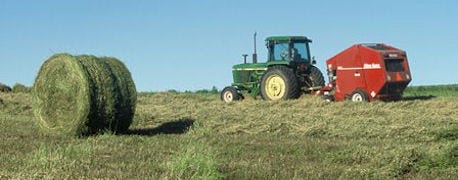March 20, 2013

With hay at $100 per ton or more it will likely pay to enhance yields, reduce loses and minimize forage needs, says John Dhuyvetter, area Extension livestock specialist at North Dakota State University's North Central Research Extension Center near Minot, N.D.
He suggests the following 14 ways accomplish those goals:
1. Renovate old hay stands that no longer are productive. Including a legume such as alfalfa in grass-dominated fields can boost nitrogen levels without the cost of applying a commercial fertilizer.
2. Plant newer forage species and varieties because they will likely be more productive.
3. Plan for more timely cuttings to maximize feed nutrients.

Hay is more worth more this year and will likely pay to try to increase yields and reduce losses.
4. Keep harvesting equipment well-maintained to minimize losses.
5. Ensile forage where available acreage is limited and you need a high quantity of feed or high-quality forage is beneficial. The cost per nutrient can be favorable in spite of silage production costs when yield is high.
6. Select hybrids that do well in your area, plant early, and provide good weed control and fertility to increase yield potential.
7. Harvest at the optimum moisture, pack the forage correctly and cover it to help reduce potentially high storage losses.
8. Maximize the use of low-cost roughage by providing supplementation, particularly in corn-growing regions.
9. Graze stover left behind when corn is harvested to reduce the need for hay and to extend grazing, further reducing feeding costs. New procedures are being developed to harvest, grind and treat residues to enhance their digestibility as a feed.
10. Grow a second crop (for example, a mixture of oats, radishes and turnips) after the early harvest of peas or barley in areas where fall moisture can be anticipated to germinate a second crop to provide additional fall grazing.
11. Consider planting a high-yielding annual forage such as oats, millet or hybrid sorghum-sudan when cash crops fail (hail, disease, poor emergence, etc.). With attention to fertility and weed control, these forage crops have the potential to yield more than 2 tons per acre of a high-quality forage. If fencing and water are available, these crops can be grazed or windrowed and left for late grazing rather than cut, cured and baled.
12. Use bale feeders to reduce hay waste when feeding more than a day's feed to smaller groups of cattle. The design, durability and price affect the effectiveness and cost of using bale feeders. Consider hay-saving designs that allow for more room per bale, and have slanted bars, greater height and a means of suspending the bale off the ground.
13. Bale graze larger groups with a multiple-day supply of bales in the field to reduce feeding commitments and leave the manure dispersed in the fields. However, this option must be managed carefully to minimize waste and maintain cow condition. Include some low-quality forage as cereal straw in combination with some moderate- and higher-quality bales for no more than three to five days. A good estimation of cow weight and bale weights is helpful when bale grazing.
14. Provide adequate protein in the ration to supply microorganisms with nitrogen, which is critical to the efficient breakdown of fiber and forage utilization. Forage analyses can help determine if and what may be needed, and how best to deliver it.
Source: NDSU Extension
Want more? Whether a producer grows hay to feed his livestock or someone else's, the enterprise is not worthwhile unless it makes money. With the lack of feed combined with rising costs of the feed available, good hay is becoming hard to come by. Consider these 10 Hay Farming Basics to maximize the quality of your hay product. Check out our Free Report from Farm Progress.
You May Also Like




